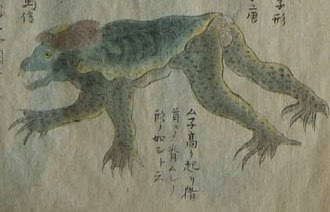We arrived at Kamikochi around 6 pm, but the sun was still up. Officers working at the bus terminal spoke really good English. He told us to head to WEST until we see a big river. The Kappa Bridge is a few hundred meters up the river. That's where our hotel are located: Alphine Hotel.
The night before heading out to Kamikochi, I watched a movie called Kappa no Natsu (Summer Days with Coo). Interested people please check out its wikipedia page: http://en.wikipedia.org/wiki/Summer_Days_with_Coo
Japanese animes often pick malevolent mythological monsters and turn them into lovely innocent, sometimes super-powerful animals that are especially amenable to kids.
Kappa in old drawing
Another good example is My Neighbor Totoro:
However Totoro in Japanese stories is a destructive monster.
Alpine hotel's dinner was an absolute artifact.
Shown is called IWANA(岩鱼), the fish that is native here. The water comes from the melting snow on top of the mountains, so pristine that the fish living in it had awesome texture. Especially the brain parts, tastes magical.
Putting beef, mushroom, onions on a pottery plate and put that plate directly on fire to cook the beef. No cooking oil or salt was used. In the end, spray some spice and all ready to eat! Alphine hotel's food is so stylish!
However, it seemed that the water pumping system was always at work during the night, we could not fall asleep, so the second day, after we enjoyed another awesome breakfast that has tofu soup in a paper cooked on fire (again, very stylish!), we changed to the hotel right next door called Nishi-itoya sanso.
Settling down we eventually got to explore the ambience. River is so beautiful, its a diamond in the valley. I don't suggest you buy bottled water from vending machine in kamikochi, the precious thing comes from every branch of river, perfect to take a handful and drink on site!
Saturday's sunshine is a good scene:
Hotaka Mountain Range. 2500 km average:
Myojin-pond, you can also find small IWANA fish:
From Myojin-pond to Tokusawa area, first time ever in my life seeing wild monkeys. They were relaxedly picking ticks for each other, or sometimes solo pick their feet like this (扒脚大汉):
They especially enjoy eating the stem of this vegetation. we also tried, but doesn't taste anything, just watery. If you know what is this plantation called, please tell me :)
There was also a great number of butterfly on the way, maybe 60 different kinds all in the single Kamikochi area.











